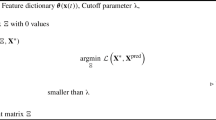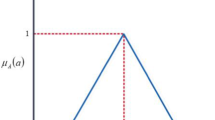Abstract
Chatter has a detrimental effect on the milling process, which makes the chatter stability prediction very critical in milling. This paper presents a new semi-discretization method (SDM) based on predictor-corrector scheme to predict the stability of milling process. Firstly, the dynamic of the milling system is modelled by delay-differential equation (DDE), and the forced vibration duration is divided into many parts. Secondly, the DDE is integrated on the small time interval. The time-delay term and the periodic coefficient matrix are taken as an operator and approximated by second-order interpolation polynomial. And then, the state transition matrix is constructed based on predictor-corrector scheme. The proposed method is validated by comparing it with the benchmark. In general, the proposed method is superior compared with the benchmark in terms of the rate of convergence. Besides, the proposed method is also a robust method. The computational efficiency of the proposed method is proved to be good. For a one degree of freedom (1-DOF) milling system under full immersion condition, the stability lobe diagrams obtained by the proposed method are much closer to the reference than those obtained by the PCHDM and UNIM, especially in the peak of the lobes. The proposed method also can be used to predict the stability for a 2-DOF milling system accurately. It is also indicated from this study that the prediction accuracy of the SDM can be improved by combining the predictor-corrector scheme.









Similar content being viewed by others
Data availability
All data generated or analyzed during this study are included in this published article.
References
Altintas Y, Budak E (1995) Analytical prediction of stability lobes in milling. CIRP Ann Manuf Technol 44(1):357–362. https://doi.org/10.1016/S0007-8506(07)62342-7
Budak E, Altintas Y (1998) Analytical prediction of chatter stability in milling—part I: general formulation. Trans ASME J Dyn Syst Meas Control 120(1):22–30. https://doi.org/10.1115/1.2801317
Budak E, Altintas Y (1998) Analytical prediction of chatter stability in milling—part II: application of the general formulation to common milling systems. Trans ASME J Dyn Syst Meas Control 120(1):31–36. https://doi.org/10.1115/1.2801318
Merdol SD, Altintas Y (2004) Multi frequency solution of chatter stability for low immersion milling. J Manuf Sci Eng 126(3):459–466. https://doi.org/10.1115/1.1765139
Bayly PV, Halley JE, Mann BP, Davies MA (2003) Stability of interrupted cutting by temporal finite element analysis. J Manuf Sci Eng 125(2):220–225. https://doi.org/10.1115/1.1556860
Butcher EA, Bobrenkov OA, Bueler E, Nindujarla P (2009) Analysis of milling stability by the Chebyshev collocation method: algorithm and optimal stable immersion levels. J Comput Nonlinear Dyn 4(3):031003. https://doi.org/10.1115/1.3124088
Insperger T, Stépán G (2004) Updated semi-discretization method for periodic delay-differential equations with discrete delay. Int J Numer Methods Eng 61(1):117–141. https://doi.org/10.1002/nme.1061
Insperger T, Stépán G, Turi J (2008) On the higher-order semi-discretizations for periodic delayed systems. J Sound Vib 313(1-2):334–341. https://doi.org/10.1016/j.jsv.2007.11.040
Jiang S, Sun Y, Yuan X, Liu W (2017) A second-order semi-discretization method for the efficient and accurate stability prediction of milling process. Int J Adv Manuf Technol 92(1-4):583–595. https://doi.org/10.1007/s00170-017-0171-y
Ding Y, Zhu LM, Zhang XJ, Ding H (2010) A full-discretization method for prediction of milling stability. Int J Mach Tools Manuf 50(5):502–509. https://doi.org/10.1016/j.ijmachtools.2010.01.003
Ding Y, Zhu LM, Zhang XJ, Ding H (2010) Second-order full-discretization method for milling stability prediction. Int J Mach Tools Manuf 50(10):926–932. https://doi.org/10.1016/j.ijmachtools.2010.05.005
Guo Q, Sun YW, Jiang Y (2012) On the accurate calculation of milling stability limits using third-order full-discretization method. Int J Mach Tools Manuf 62:61–66. https://doi.org/10.1016/j.ijmachtools.2012.07.008
Ozoegwu CG (2014) Least squares approximated stability boundaries of milling process. Int J Mach Tools Manuf 79:24–30. https://doi.org/10.1016/j.ijmachtools.2014.02.001
Ozoegwu CG, Omenyi SN, Ofochebe SM (2015) Hyper-third order full-discretization methods in milling stability prediction. Int J Mach Tools Manuf 92:1–9. https://doi.org/10.1016/j.ijmachtools.2015.02.007
Tang X, Peng F, Yan R, Gong Y, Li Y, Jiang L (2016) Accurate and efficient prediction of milling stability with updated full-discretization method. Int J Adv Manuf Technol 88(9-12):2357–2368. https://doi.org/10.1007/s00170-016-8923-7
Yan ZH, Wang XB, Liu ZB, Wang DQ, Jiao L, Ji YJ (2017) Third-order updated full-discretization method for milling stability prediction. Int J Adv Manuf Technol 92(5-8):2299–2309. https://doi.org/10.1007/s00170-017-0243-z
Zhou K, Feng P, Xu C, Zhang J, Wu Z (2017) High-order full-discretization methods for milling stability prediction by interpolating the delay term of time-delayed differential equations. Int J Adv Manuf Technol 93(5-8):2201–2214. https://doi.org/10.1007/s00170-017-0692-4
Qin C, Tao J, Liu C (2019) A novel stability prediction method for milling operations using the holistic-interpolation scheme. Proc Inst Mech Eng C J Mech Eng Sci 233(13):4463–4475. https://doi.org/10.1177/0954406218815716
Qin C, Tao J, Liu C (2018) A predictor-corrector-based holistic-discretization method for accurate and efficient milling stability analysis. Int J Adv Manuf Technol 96:2043–2054. https://doi.org/10.1007/s00170-018-1727-1
Dai Y, Li H, Hao B (2018) An improved full-discretization method for chatter stability prediction. Int J Adv Manuf Technol 96(9-12):3503–3510. https://doi.org/10.1007/s00170-018-1767-6
Dai Y, Li H, Xing X, Hao B (2018) Prediction of chatter stability for milling process using precise integration method. Precis Eng 52:152–157. https://doi.org/10.1016/j.precisioneng.2017.12.003
Li HK, Dai YB, Fan ZF (2019) Improved precise integration method for chatter stability prediction of two-DOF milling system. Int J Adv Manuf Technol 101(1):1235–1246
Yang WA, Huang C, Cai X, You Y (2020) Effective and fast prediction of milling stability using a precise integration-based third-order full-discretization method. Int J Adv Manuf Technol 106(9):4477–4498. https://doi.org/10.1007/s00170-019-04790-z
Ding Y, Zhu LM, Zhang XJ, Ding H (2013) Stability analysis of milling via the differential quadrature method. J Manuf Sci E T ASME 135(4):044502. https://doi.org/10.1115/1.4024539
Zhang XJ, Xiong CH, Ding Y, Ding H (2017) Prediction of chatter stability in high speed milling using the numerical differentiation method. Int J Adv Manuf Technol 89(9-12):2535–2544. https://doi.org/10.1007/s00170-016-8708-z
Niu JB, Ding Y, Zhu LM, Ding H (2014) Runge–Kutta methods for a semi-analytical prediction of milling stability. Nonlinear Dyn 76(1):289–304. https://doi.org/10.1007/s11071-013-1127-x
Zhang Z, Li HG, Meng G, Liu C (2015) A novel approach for the prediction of the milling stability based on the Simpson method. Int J Mach Tools Manuf 99:43–47. https://doi.org/10.1016/j.ijmachtools.2015.09.002
Qin CJ, Tao JF, Li L, Liu CL (2017) An Adams-Moulton-based method for stability prediction of milling processes. Int J Adv Manuf Technol 89(9-12):3049–3058. https://doi.org/10.1007/s00170-016-9293-x
Ding Y, Zhu LM, Zhang XJ, Ding H (2011) Numerical integration method for prediction of milling stability. J Manuf Sci Eng 133(3):031005. https://doi.org/10.1115/1.4004136
Dong X, Qiu Z (2020) Stability analysis in milling process based on updated numerical integration method. Mech Syst Signal Process 137:106435. https://doi.org/10.1016/j.ymssp.2019.106435
Li WT, Wang LP, Yu G (2020) An accurate and fast milling stability prediction approach based on the Newton-Cotes rules. Int J Mech Sci 177:105469. https://doi.org/10.1016/j.ijmecsci.2020.105469
Code availability
Not applicable.
Funding
This research was funded by the Special Fund for Talents of Gansu Agricultural University (2017RCZX-21 and GAU-KYQD-2018-29), and the National Natural Science Foundation of China (61661003 and 61862002), and the Gansu Agricultural University FuXi Talent Program (GAUFX-02J01) and the discipline construction fund (GAU-XKJS-2018-190).
Author information
Authors and Affiliations
Contributions
Central idea, data curation, and writing—Kenan Liu and Yang Zhang; additional analyses—Xiaoyang Gao and Wanxia Yang; review and editing—Wei Sun; finalizing this paper—Fei Dai.
Corresponding author
Ethics declarations
Ethical approval
Not applicable.
Consent to participate
Not applicable.
Consent to publish
Not applicable.
Competing interest
The authors declare no conflict of interest.
Additional information
Publisher’s note
Springer Nature remains neutral with regard to jurisdictional claims in published maps and institutional affiliations.
Rights and permissions
About this article
Cite this article
Liu, K., Zhang, Y., Gao, X. et al. Improved semi-discretization method based on predictor-corrector scheme for milling stability analysis. Int J Adv Manuf Technol 114, 3377–3389 (2021). https://doi.org/10.1007/s00170-021-06747-7
Received:
Accepted:
Published:
Issue Date:
DOI: https://doi.org/10.1007/s00170-021-06747-7




